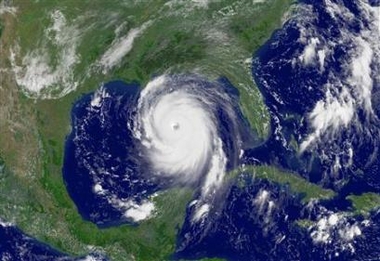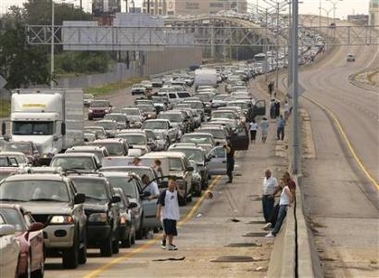|
Hurricane could leave 1 million homeless
(AP)
Updated: 2005-08-29 09:13
When Hurricane Katrina hits New Orleans on Monday, it could turn one of America's most charming cities into a vast cesspool tainted with toxic chemicals, human waste and even coffins released by floodwaters from the city's legendary cemeteries, AP reported.
Experts have warned for years that the levees and pumps that usually keep New Orleans dry have no chance against a direct hit by a Category 5 storm.
That's exactly what Katrina was as it churned toward the city. With top winds of 165 mph and the power to lift sea level by as much as 28 feet above normal, the storm threatened an environmental disaster of biblical proportions, one that could leave more than 1 million people homeless.

US National Oceanic and Atmospheric Administration satellite image of Hurricane Katrina in the Gulf of Mexico on August 28, 2005. [Reuters] |
"All indications are that this is absolutely worst-case scenario," Ivor van Heerden, deputy director of the Louisiana State University Hurricane Center, said Sunday afternoon.
The center's latest computer simulations indicate that by Tuesday, vast swaths of New Orleans could be under water up to 30 feet deep. In the French Quarter, the water could reach 20 feet, easily submerging the district's iconic cast-iron balconies and bars.
Estimates predict that 60 percent to 80 percent of the city's houses will be destroyed by wind. With the flood damage, most of the people who live in and around New Orleans could be homeless.
"We're talking about in essence having — in the continental United States — having a refugee camp of a million people," van Heerden said.

Drivers and passengers wait outside their cars as traffic snarls on the interstate highway leaving downtown New Orleans August 28, 2005. Authorities in New Orleans ordered hundreds of thousands of residents to flee on Sunday as Hurricane Katrina strengthened into a rare top-ranked storm and barreled towards the vulnerable U.S. Gulf Coast city. [Reuters] |
Aside from Hurricane Andrew, which struck Miami in 1992, forecasters have no experience with Category 5 hurricanes hitting densely populated areas.
"Hurricanes rarely sustain such extreme winds for much time. However we see no obvious large-scale effects to cause a substantial weakening the system and it is expected that the hurricane will be of Category 4 or 5 intensity when it reaches the coast," National Hurricane Center meteorologist Richard Pasch said.
As they raced to put meteorological instruments in Katrina's path Sunday, wind engineers had little idea what their equipment would record.
"We haven't seen something this big since we started the program," said Kurt Gurley, a University of Florida engineering professor. He works for the Florida Coastal Monitoring Program, which is in its seventh year of making detailed measurements of hurricane wind conditions using a set of mobile weather stations.
Experts have warned about New Orleans' vulnerability for years, chiefly because Louisiana has lost more than a million acres of coastal wetlands in the past seven decades. The vast patchwork of swamps and bayous south of the city serves as a buffer, partially absorbing the surge of water that a hurricane pushes ashore.
Experts have also warned that the ring of high levees around New Orleans, designed to protect the city from floodwaters coming down the Mississippi, will only make things worse in a powerful hurricane. Katrina is expected to push a 28-foot storm surge against the levees. Even if they hold, water will pour over their tops and begin filling the city as if it were a sinking canoe.
After the storm passes, the water will have nowhere to go.
In a few days, van Heerden predicts, emergency management officials are going to be wondering how to handle a giant stagnant pond contaminated with building debris, coffins, sewage and other hazardous materials.
"We're talking about an incredible environmental disaster," van Heerden said.
He puts much of the blame for New Orleans' dire situation on the very levee system that is designed to protect southern Louisiana from Mississippi River floods.
Before the levees were built, the river would top its banks during floods and wash through a maze of bayous and swamps, dropping fine-grained silt that nourished plants and kept the land just above sea level.
The levees "have literally starved our wetlands to death" by directing all of that precious silt out into the Gulf of Mexico, van Heerden said.
It has been 40 years since New Orleans faced a hurricane even comparable to Katrina. In 1965, Hurricane Betsy, a Category 3 storm, submerged some parts of the city to a depth of seven feet.
Since then, the Big Easy has had nothing but near misses. In 1998, Hurricane Georges headed straight for New Orleans, then swerved at the last minute to strike Mississippi and Alabama. Hurricane Lili blew herself out at the mouth of the Mississippi in 2002. And last year's Hurricane Ivan obligingly curved to the east as it came ashore, barely grazing a grateful city.
|